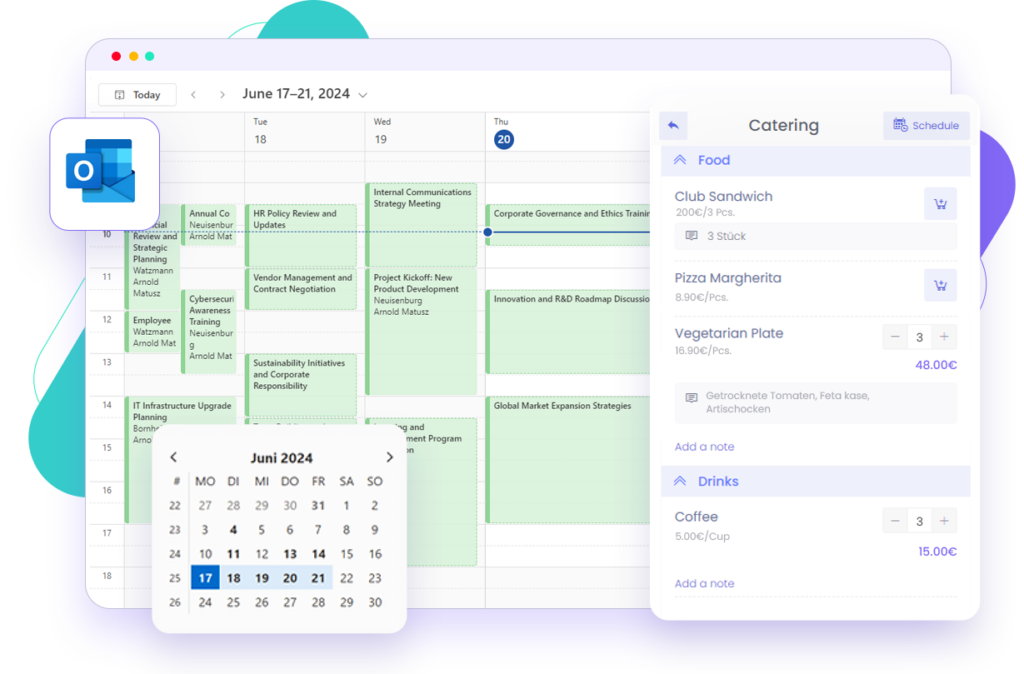How the introduction of arbooMEET transforms the workday
Change Management for the introduction of arbooMEET
This is how we support the implementation of arbooMEET in your company: Practical insights from various perspectives
The introduction of arbooMEET, an Outlook add-in for room booking and the management of additional services such as seating arrangements and catering, brings changes to existing processes. These changes affect different perspectives within the company, from end users to administrators and specialized departments such as facility management and office managers. To ensure the smoothest possible transition, the respective stakeholders must clearly understand how their workflows will change and what new responsibilities they will need to take on.
1. From the perspective of the users (employees)
For end users, who may have previously organized room bookings manually via email or separate tools, arbooMEET offers significant simplification. The ability to book meeting rooms directly in Outlook while simultaneously integrating additional services such as catering or seating arrangements saves a lot of time and reduces effort.
Practical changes for users:
- Centralized booking platform: Previously, employees may have had to fill out separate forms or send emails for catering and room reservations. With arbooMEET, all bookings and service requests can now be managed centrally through Outlook.
- Automated process execution: Employees no longer need to worry about whether seating arrangements or catering are provided on time. arbooMEET ensures that all requirements are automatically triggered for the facility management and catering teams.
- Training and guidance: Users need to understand how to integrate these additional functions into their booking requests. It is important to provide simple instructions that show step by step how to add catering or seating.
2. From the perspective of the administrators (e.g., office managers)
Office managers and administrators, who may have previously coordinated room bookings and additional services manually (e.g., via Excel spreadsheets or separate booking requests), benefit from the automation provided by arbooMEET. Centralized management simplifies the control and tracking of all bookings and related requirements.
Practical changes for administrators:
- Automatic notifications: Instead of manually forwarding orders for catering or seating, this is now triggered directly when booking rooms through arbooMEET. Administrators must ensure that all relevant booking details are correctly entered into the system.
- Management of booking quotas: Some administrators previously managed room bookings and resources like catering or technical equipment directly. With arbooMEET, administrators should verify that the available services and room resources are correctly configured in the system. Room management and resource allocation now occur centrally, and administrators can immediately track who has booked which services.
- Reporting and tracking: Administrators now have better visibility into all room bookings and additional services. They should regularly monitor the usage of rooms and services to plan resources optimally and identify any potential bottlenecks
3. From the perspective of Facility Management (seating, technology, and services)
Facility managers need to adjust their processes for providing seating, technical equipment, or other services. Before the introduction of arbooMEET, these requests were often handled via email or through manual forwarding of room reservations. Now, these requests are automatically triggered as soon as a room is booked and the corresponding additional services are selected.
Practical changes for Facility Management:
- Automation of service requests: Previously, facility managers had to manually receive and schedule each request for seating or technical equipment. With the introduction of arbooMEET, such requirements are recorded directly during the room booking process, so facility managers are automatically notified when, for example, a specific room with a particular seating arrangement is needed.
- Integration into the room planning process: Facility managers should input their capacities and resource quotas (e.g., seating types or technical equipment) into the system. It must be verified whether the room can be equipped for the requested services. If not, the facility manager may need to offer alternative options.
- Planning of additional services: Facility managers must ensure they are prepared for the new requirements (such as specific seating or additional services) and have sufficient resources available.
4. From the perspective of the catering team
The catering team is also faced with new challenges and changes through the introduction of arbooMEET. While catering services may have previously been requested manually or managed through separate systems, this is now coordinated directly via the Outlook add-in.
Practical changes for catering teams:
- Direct booking of catering via Outlook: Before the introduction of arbooMEET, catering teams often had to wait for separate orders or emails from users. Now, catering for an event is automatically planned alongside the room booking. This allows for better coordination and quicker response times.
- Necessary adjustments to catering options: Catering teams must ensure that all relevant options (e.g., menu selection, vegan options, special requirements) are entered into the system. Clear processes should be defined for how special requirements are handled and accommodated.
- Improved planning and lead time: Since catering is now integrated directly with room and service bookings, catering teams need to adjust their internal workflows to provide the required resources early. They must ensure that sufficient staff and materials are available to fulfill the ordered services.
Conclusion
The introduction of arbooMEET brings significant changes not only for end users but also for administrators, facility managers, and the catering team. By automating and centralizing room bookings and additional services, existing processes are optimized. To implement these changes successfully, targeted training and close collaboration between departments are essential. Effective change management ensures that all stakeholders become familiar with the new workflows and can fully leverage the benefits of the new solution.

Related Content
Meeting Room Booking as It Should Be, Straight from Microsoft Outlook


